Effect of Al/Mg Ratio on the Microstructure and Phase Distribution of Zn-Al-Mg Coatings
Abstract
:1. Introduction
2. Experimental Materials and Methods
2.1. Material Preparation
2.2. Characterization and Statistics
3. Results and Analysis
3.1. Characterization of Coating Phases
3.2. Thermodynamic Simulations and Statistical Calculations
3.3. Effect of the Corrosion Performance
4. Conclusions
- The typical microstructure of the Zn-Al-Mg coatings with low aluminum was composed of Hcp-Zn, a binary eutectic phase (Hcp-Zn/MgZn2), and a ternary eutectic phase (Hcp-Zn/MgZn2/Fcc-Al). The content of aluminum was 1.6 wt.%, according to the coloring statistics in the SEM photos of the plated layer. Hcp-Zn decreased with the increase in the Mg/Al ratio, while the binary eutectic phase, in contrast, gradually increased, and the trend of change in the ternary eutectic phase was not obvious.
- The results of the thermodynamic simulations show that with the increase in the Mg/Al ratio, the MgZn2 phase in the Zn-Al-Mg coatings gradually increased, and the Hcp-Zn phase diminished. Meanwhile, the binary eutectic phase tended to increase, which is consistent with the trend of the statistical results in the coating photos. The tendency of the change in the ternary eutectic phase was not evident, which was mainly due to the same set value of the Al elemental composition in the coating, which means that the change in the ternary eutectic phase mainly depended on the amount of Al added.
- The cyclic immersion corrosion test showed that the coating with a higher Mg/Al ratio in a 3.5 wt.% NaCl solution possessed better corrosion protection properties, which mainly occurred due to an increase in the proportion of the MgZn2 phase.
Author Contributions
Funding
Data Availability Statement
Conflicts of Interest
References
- Yu, K.C.; Li, J.; Liu, X.; Li, J.G.; Xue, X.H. Microstructure of hot-dip galvanized Zn-Al-Mg alloy coating. J. Shanghai Jiaotong Univ. (Sci.) 2012, 17, 663–667. [Google Scholar] [CrossRef]
- Wang, Y.-Q.; Kong, G.; Che, C.-S. Corrosion Behavior of Zn-Al, Zn-Mg, and Zn-Mg-Al Coatings in Simulated Concrete Pore Solution. Corrosion 2018, 75, 203–209. [Google Scholar] [CrossRef] [PubMed]
- Prosek, T.; Hagström, J.; Persson, D.; Fuertes, N.; Lindberg, F.; Chocholatý, O.; Taxén, C.; Šerák, J.; Thierry, D. Effect of the microstructure of Zn-Al and Zn-Al-Mg model alloys on corrosion stability. Corros. Sci. 2016, 110, 71–81. [Google Scholar] [CrossRef]
- Stoulil, J.; Prosek, T.; Nazarov, A.; Oswald, J.; Kriz, P.; Thierry, D. Electrochemical properties of corrosion products formed on Zn-Mg, Zn-Al and Zn-Al-Mg coatings in model atmospheric conditions. Mater. Corros. 2015, 66, 777–782. [Google Scholar] [CrossRef]
- Jiang, S.M.; Yue, C.F.; Zhang, Q.F. Coating Structure and Corrosion Resistance Behavior of Hot Dip Zn-Al-Mg-Si Alloy Coating Steel Sheet. Adv. Mater. Res. 2013, 834–836, 601–608. [Google Scholar] [CrossRef]
- Prosek, T.; Nazarov, A.; Le Gac, A.; Thierry, D. Coil-coated Zn–Mg and Zn–Al–Mg: Effect of climatic parameters on the corrosion at cut edges. Prog. Org. Coat. 2015, 83, 26–35. [Google Scholar] [CrossRef]
- Gogola, P.; Gabalcova, Z.; Kusy, M.; Suchanek, H. The Effect of Sn Addition on Zn-Al-Mg Alloy; Part I: Microstructure and Phase Composition. Materials 2021, 14, 5404. [Google Scholar] [CrossRef] [PubMed]
- Gabalcova, Z.; Gogola, P.; Kusy, M.; Suchanek, H. The Effect of Sn Addition on Zn-Al-Mg Alloy; Part II: Corrosion Behaviour. Materials 2021, 14, 5290. [Google Scholar] [CrossRef]
- Hai Tat, L.; Bakhsheshi-Rad, H.R.; Hamzah, E.; Cho, M.H.; Mostafa, A.; Farahany, S. Microstructure, phase evolution and corrosion behaviour of the Zn–Al–Mg–Sb alloy coating on steel. Mater. Sci. Technol. 2019, 36, 353–366. [Google Scholar] [CrossRef]
- Wang, P.J.; Ma, L.W.; Cheng, X.Q.; Li, X.G. Influence of grain refinement on the corrosion behavior of metallic materials: A review. Int. J. Miner. Metall. Mater. 2021, 28, 1112–1126. [Google Scholar] [CrossRef]
- Li, B.; Dong, A.; Zhu, G.; Chu, S.; Qian, H.; Hu, C.; Sun, B.; Wang, J. Investigation of the corrosion behaviors of continuously hot-dip galvanizing Zn–Mg coating. Surf. Coat. Technol. 2012, 206, 3989–3999. [Google Scholar] [CrossRef]
- De Bruycker, E.; Zermout, Z.; De Cooman, B.C. Zn-Al-Mg Coatings: Thermodynamic Analysis and Microstructure Related Properties. Mater. Sci. Forum 2007, 539–543, 1276–1281. [Google Scholar] [CrossRef]
- Costa, A.N.C.; Silva, G.C.; Ferreira, E.A.; Nakazato, R.Z. Comparative analysis of corrosion resistance of Zinc and Zn-Al-Mg coatings on carbon steel. Res. Soc. Dev. 2021, 10, e49810111973. [Google Scholar] [CrossRef]
- Duchoslav, J.; Arndt, M.; Keppert, T.; Luckeneder, G.; Stifter, D. XPS investigation on the surface chemistry of corrosion products on ZnMgAl-coated steel. Anal. Bioanal. Chem. 2013, 405, 7133–7144. [Google Scholar] [CrossRef] [PubMed]
- Çetinkaya, B.W.; Junge, F.; Müller, G.; Haakmann, F.; Schierbaum, K.; Giza, M. Impact of alkaline and acid treatment on the surface chemistry of a hot-dip galvanized Zn–Al–Mg coating. J. Mater. Res. Technol. 2020, 9, 16445–16458. [Google Scholar] [CrossRef]
- Ahmadi, M.; Salgın, B.; Kooi, B.J.; Pei, Y. Cracking behavior and formability of Zn-Al-Mg coatings: Understanding the influence of steel substrates. Mater. Des. 2021, 212, 110215. [Google Scholar] [CrossRef]
- Lin, S.; Okuda, H.; Matsumoto, K.; Yamaguchi, M.; Sato, K. Nanostructure Distribution and Strengthening Mechanisms in the Interface Regions of Al–Zn/Al–Mg Multilayered Composites. Mater. Trans. 2021, 62, 603–609. [Google Scholar] [CrossRef]
- LeBozec, N.; Thierry, D.; Persson, D.; Riener, C.K.; Luckeneder, G. Influence of microstructure of zinc-aluminium-magnesium alloy coated steel on the corrosion behavior in outdoor marine atmosphere. Surf. Coat. Technol. 2019, 374, 897–909. [Google Scholar] [CrossRef]
- LeBozec, N.; Thierry, D.; Peltola, A.; Luxem, L.; Luckeneder, G.; Marchiaro, G.; Rohwerder, M. Corrosion performance of Zn-Mg-Al coated steel in accelerated corrosion tests used in the automotive industry and field exposures. Mater. Corros. 2013, 64, 969–978. [Google Scholar] [CrossRef]
- Commenda, C.; Pühringer, J. Microstructural characterization and quantification of Zn–Al–Mg surface coatings. Mater. Charact. 2010, 61, 943–951. [Google Scholar] [CrossRef]
- Dutta, M.; Halder, A.K.; Singh, S.B. Morphology and properties of hot dip Zn–Mg and Zn–Mg–Al alloy coatings on steel sheet. Surf. Coat. Technol. 2010, 205, 2578–2584. [Google Scholar] [CrossRef]
- Wint, N.; Cooze, N.; Searle, J.R.; Sullivan, J.H.; Williams, G.; McMurray, H.N.; Luckeneder, G.; Riener, C. The Effect of Microstructural Refinement on the Localized Corrosion of Model Zn-Al-Mg Alloy Coatings on Steel. J. Electrochem. Soc. 2019, 166, C3147–C3158. [Google Scholar] [CrossRef]
- Duchoslav, J.; Arndt, M.; Steinberger, R.; Keppert, T.; Luckeneder, G.; Stellnberger, K.H.; Hagler, J.; Riener, C.K.; Angeli, G.; Stifter, D. Nanoscopic view on the initial stages of corrosion of hot dip galvanized Zn–Mg–Al coatings. Corros. Sci. 2014, 83, 327–334. [Google Scholar] [CrossRef]
- Su, X.; Zhou, J.; Wang, J.; Wu, C.; Liu, Y.; Tu, H.; Peng, H. Thermodynamic analysis and experimental study on the oxidation of the Zn-Al-Mg coating baths. Appl. Surf. Sci. 2017, 396, 154–160. [Google Scholar] [CrossRef]
- Zhang, Z. Microstructure and Corrosion Resistance of Zn-Al-Mg Alloy Diffusion Coating developed on Carbon Steel by Hot Dipping. Int. J. Electrochem. Sci. 2020, 15, 5512–5519. [Google Scholar] [CrossRef]
- Rai, P.K.; Rout, D.; Satish Kumar, D.; Sharma, S.; Balachandran, G. Effect of Magnesium on Corrosion Behavior of Hot-Dip Zn-Al-Mg Coating. J. Mater. Eng. Perform. 2021, 30, 4138–4147. [Google Scholar] [CrossRef]
- Salgueiro Azevedo, M.; Allély, C.; Ogle, K.; Volovitch, P. Corrosion mechanisms of Zn(Mg,Al) coated steel: 2. The effect of Mg and Al alloying on the formation and properties of corrosion products in different electrolytes. Corros. Sci. 2015, 90, 482–490. [Google Scholar] [CrossRef]
- Volovitch, P.; Vu, T.N.; Allély, C.; Abdel Aal, A.; Ogle, K. Understanding corrosion via corrosion product characterization: II. Role of alloying elements in improving the corrosion resistance of Zn–Al–Mg coatings on steel. Corros. Sci. 2011, 53, 2437–2445. [Google Scholar] [CrossRef]
- Thierry, D.; Persson, D.; Luckeneder, G.; Stellnberger, K.-H. Atmospheric corrosion of ZnAlMg coated steel during long term atmospheric weathering at different worldwide exposure sites. Corros. Sci. 2019, 148, 338–354. [Google Scholar] [CrossRef]
- Prosek, T.; Larché, N.; Vlot, M.; Goodwin, F.; Thierry, D. Corrosion performance of Zn-Al-Mg coatings in open and confined zones in conditions simulating automotive applications. Mater. Corros. 2010, 61, 412–420. [Google Scholar] [CrossRef]
- Kim, J.N.; Lee, C.S.; Jin, Y.S. Structure and Stoichiometry of MgxZny in Hot-Dipped Zn–Mg–Al Coating Layer on Interstitial-Free Steel. Met. Mater. Int. 2018, 24, 1090–1098. [Google Scholar] [CrossRef]
- Zhang, Z.; Zhang, J.; Zhao, X.; Cheng, X.; Jiang, S.; Zhang, Q. Effects of Al-Mg on the Microstructure and Phase Distribution of Zn-Al-Mg Coatings. Metals 2023, 13, 46. [Google Scholar] [CrossRef]
- Rai, P.K.; Rout, D.; Kumar, D.S.; Sharma, S.; Balachandran, G. Corrosion behaviour of hot-dip Zn-Al-Mg coatings with different Al content. Anti-Corros. Methods Mater. 2022, 69, 29–37. [Google Scholar] [CrossRef]
- Xu, M.; Han, D.; Zheng, Z.; Ma, R.; Du, A.; Fan, Y.; Zhao, X.; Cao, X. Effects of cooling rate on the microstructure and properties of hot-dipped Zn–Al–Mg coatings. Surf. Coat. Technol. 2022, 444, 128665. [Google Scholar] [CrossRef]
- GB/T 19746-2018; Corrosion of Metals and Alloys—Alternate Immersion Test in Salt Solution. Standardization Administration of China: Beijing, China, 2018.
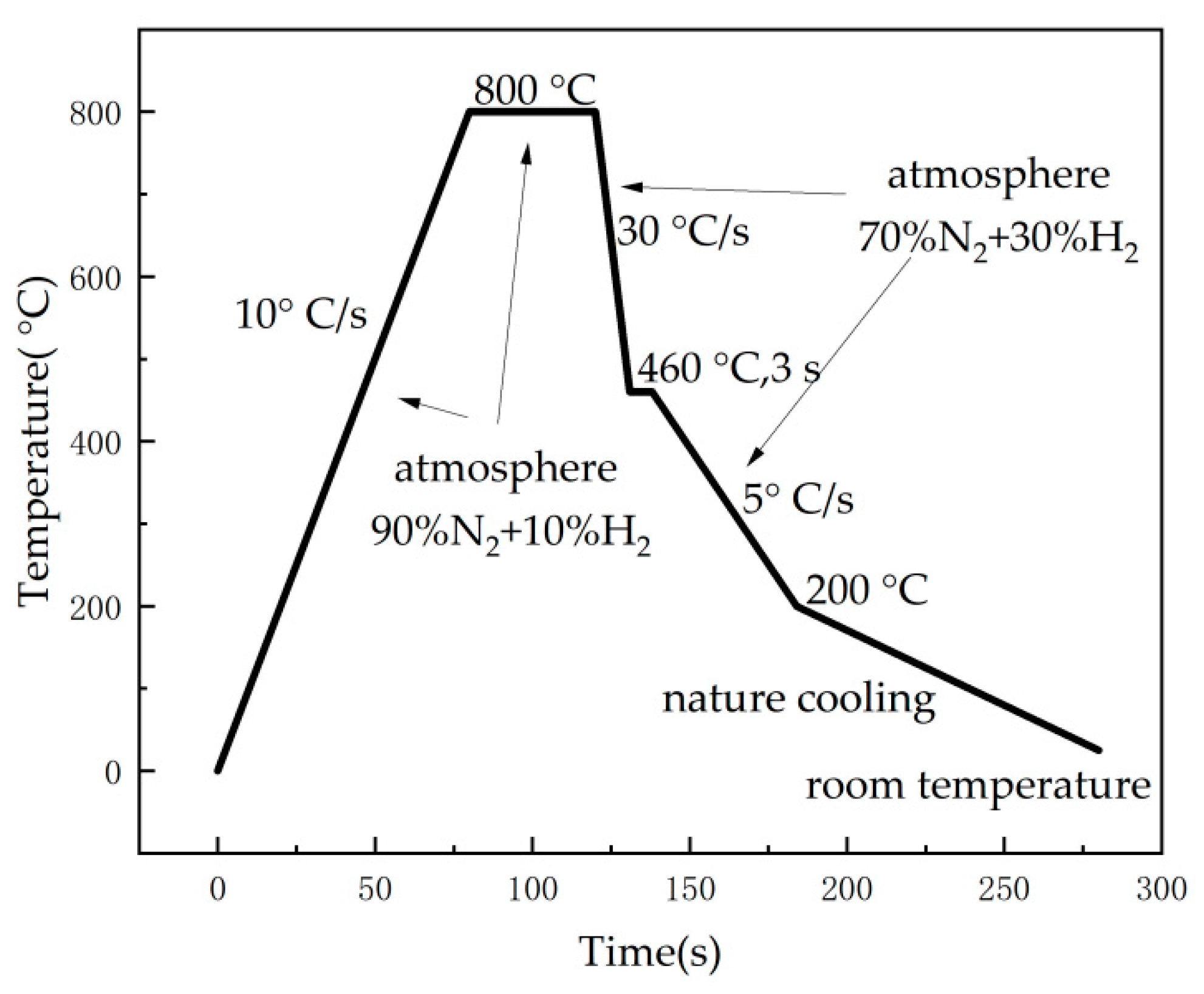
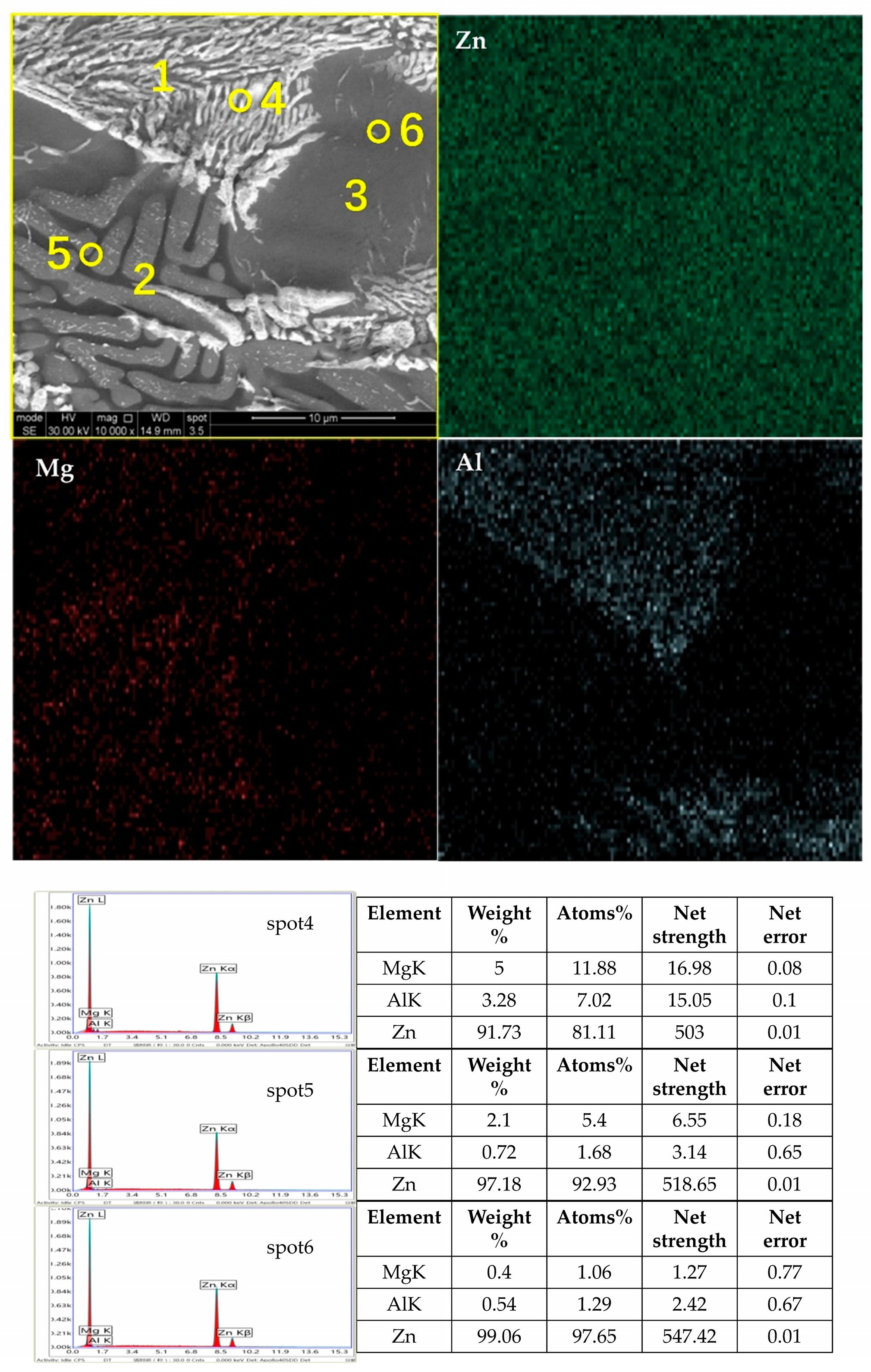


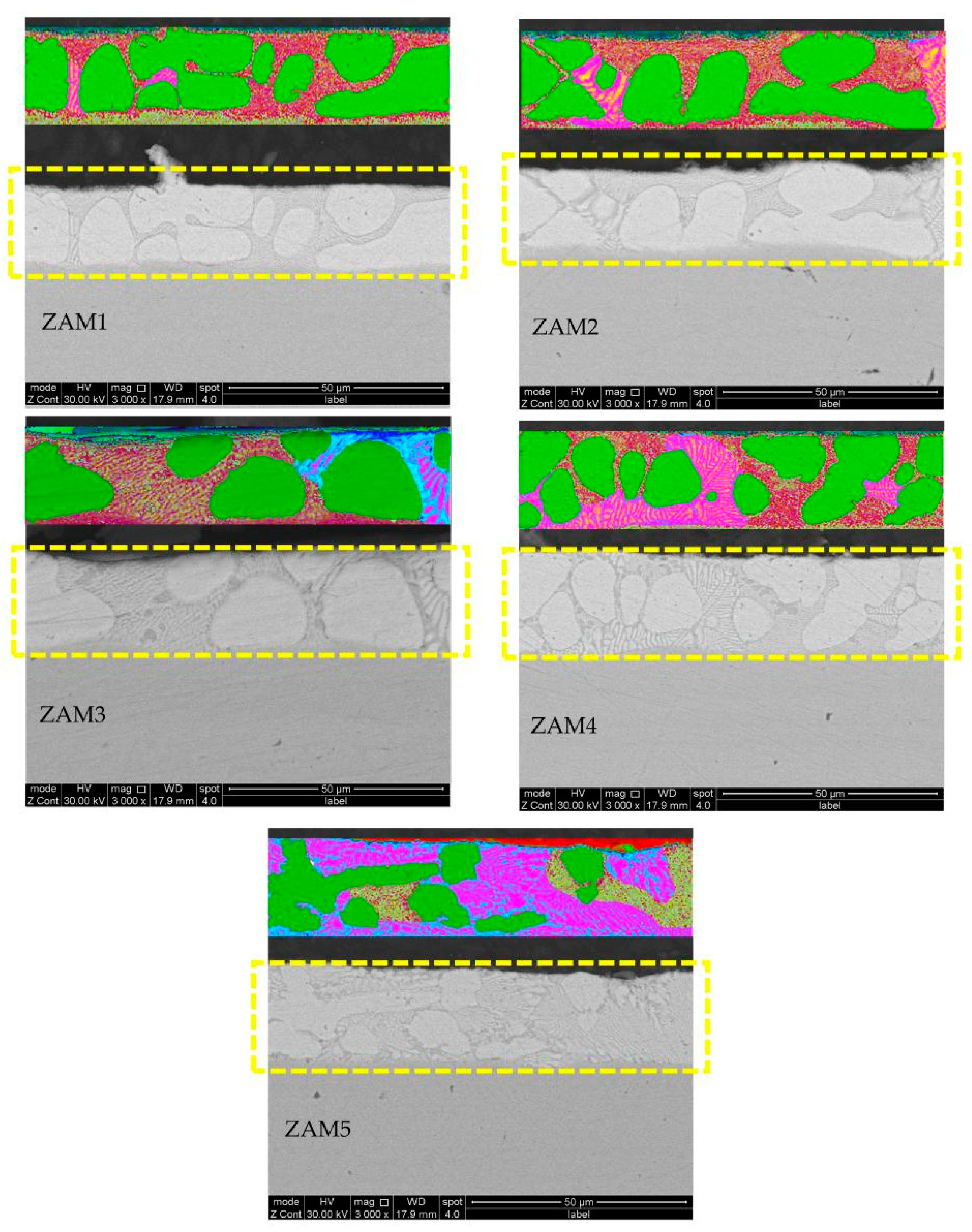
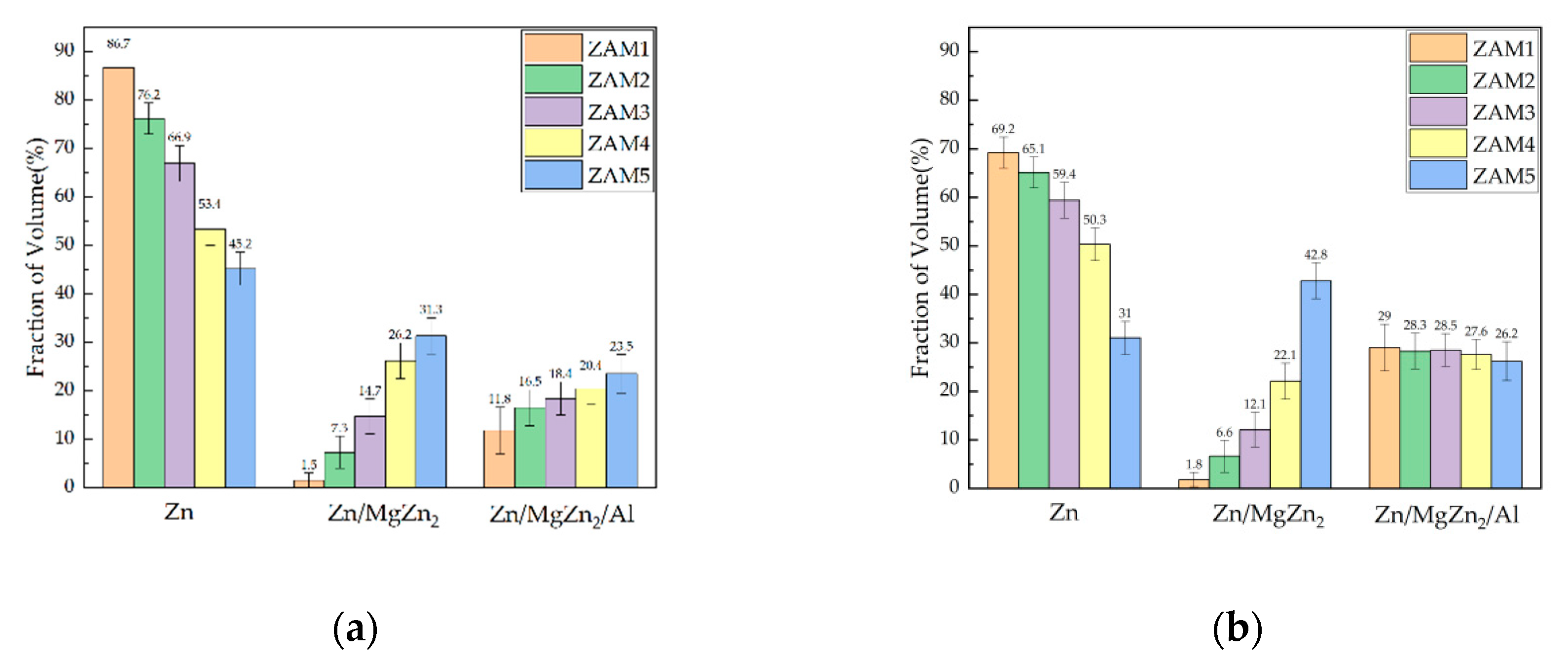
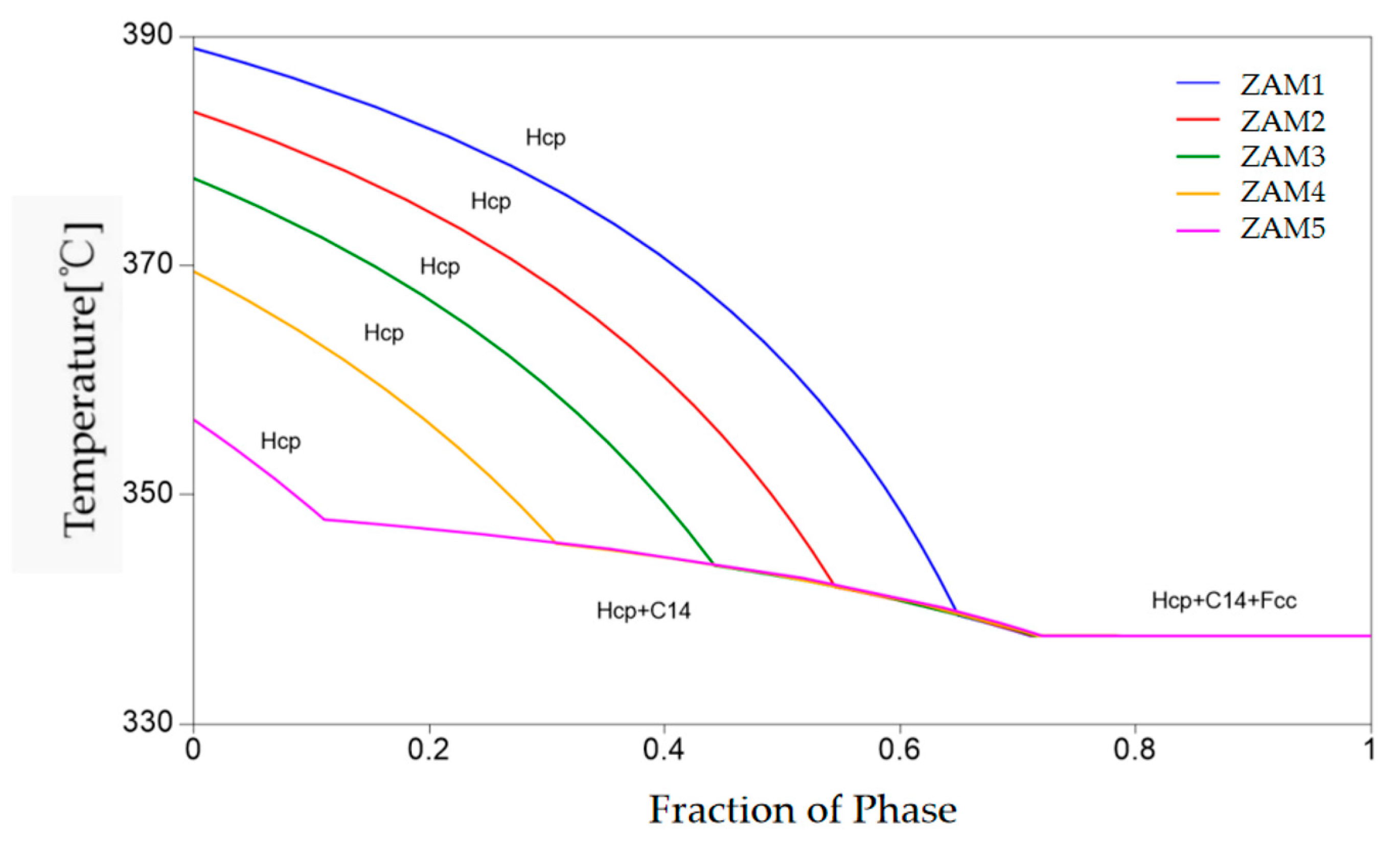
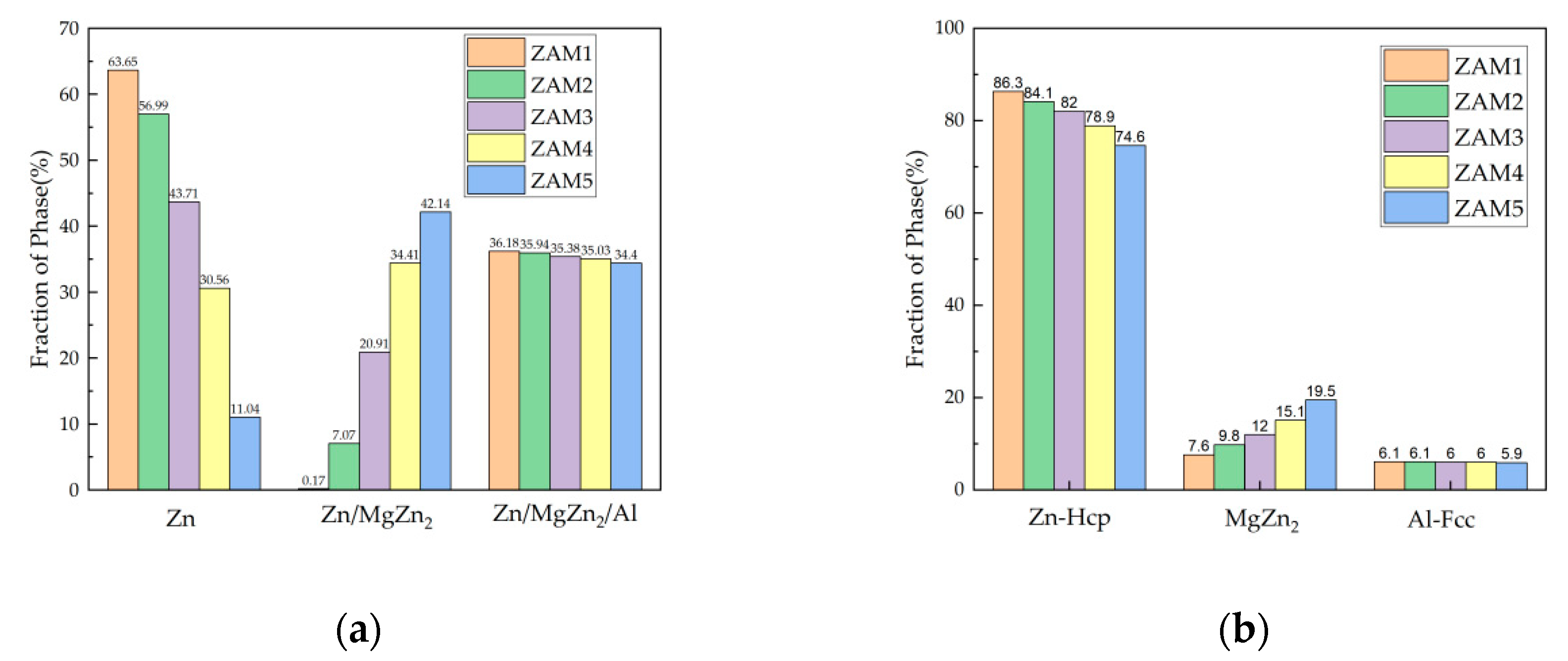
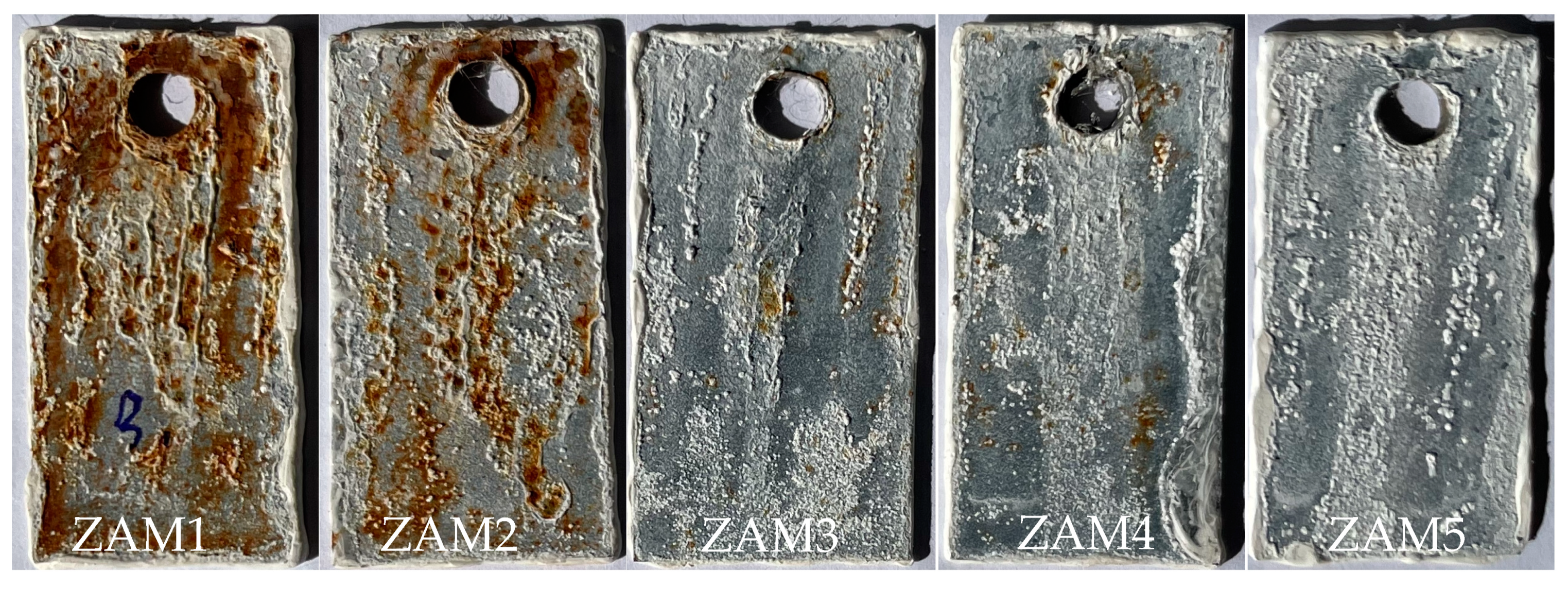
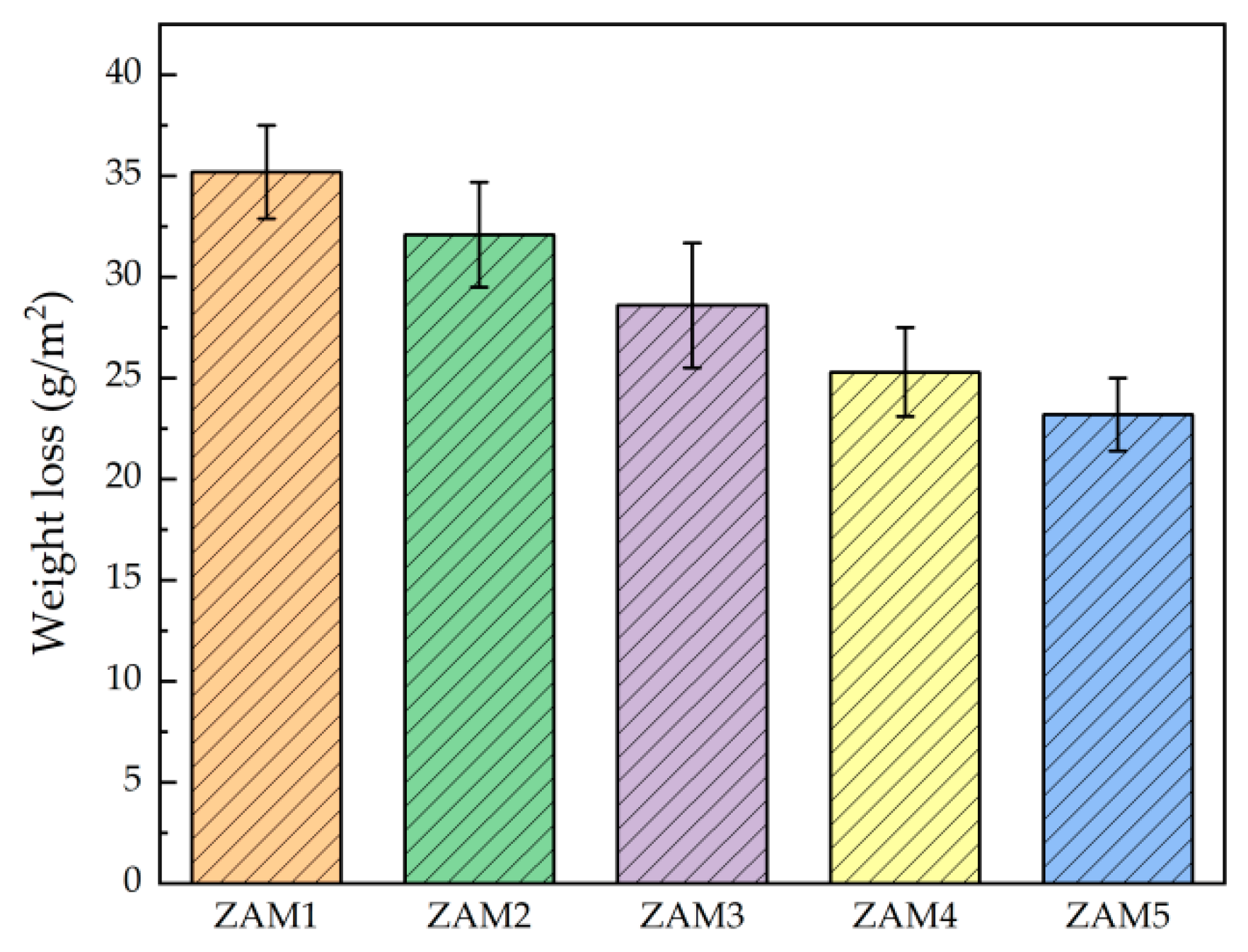
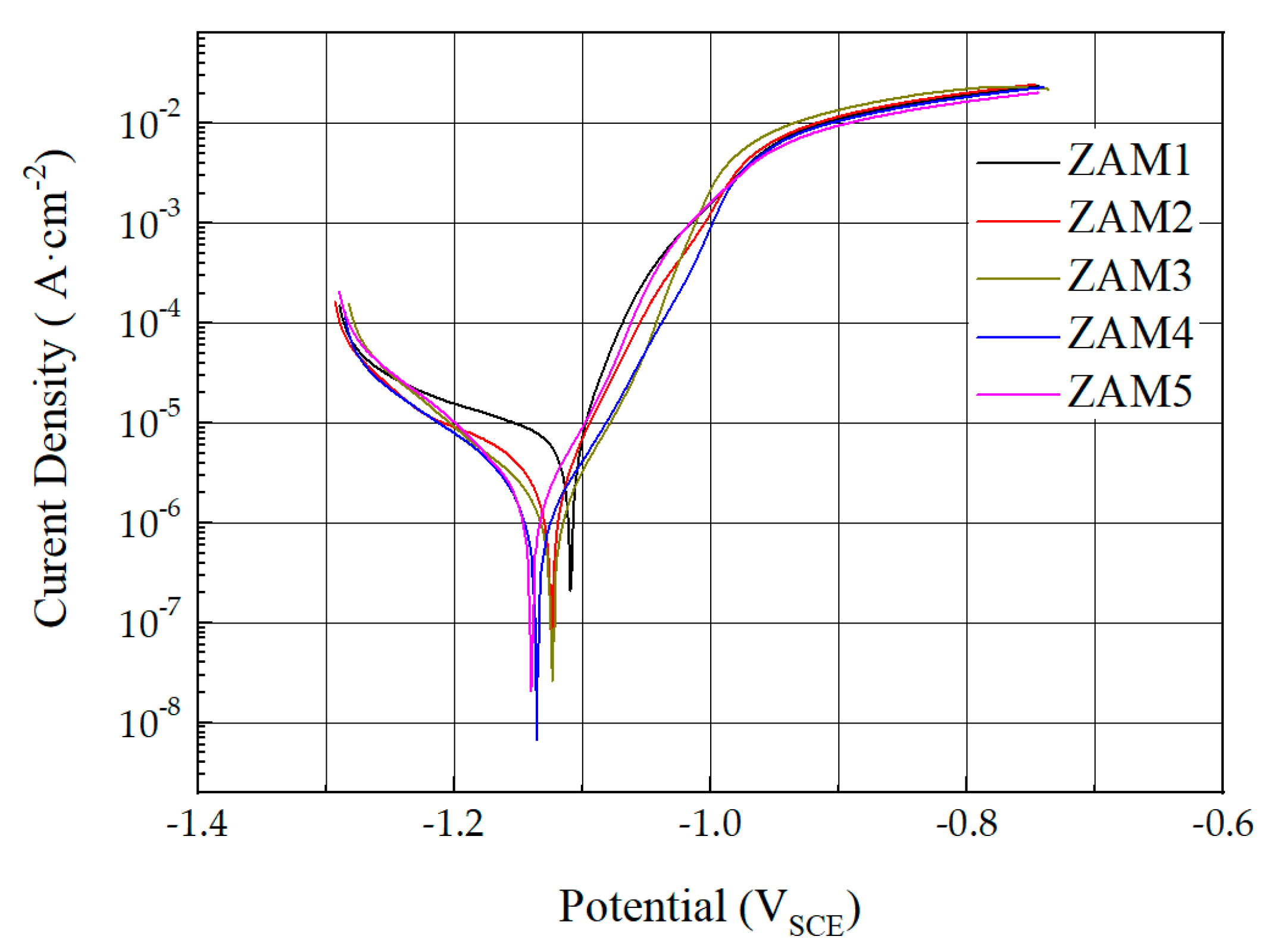
| Sample No. | Component | Mg/Al Ratio | Mg (wt.%) (±0.1) | Al (wt.%) (±0.1) | Zn (wt.%) (±0.1) |
|---|---|---|---|---|---|
| ZAM1 | Zn-1.6Al-1.0Mg | 0.63 | 1.04 | 1.62 | 97.34 |
| ZAM2 | Zn-1.6Al-1.2Mg | 0.75 | 1.22 | 1.62 | 97.16 |
| ZAM3 | Zn-1.6Al-1.6Mg | 1.00 | 1.58 | 1.61 | 96.81 |
| ZAM4 | Zn-1.6Al-2.0Mg | 1.25 | 2.05 | 1.59 | 96.36 |
| ZAM5 | Zn-1.6Al-2.6Mg | 1.63 | 2.63 | 1.58 | 95.79 |
| Coating | Ecorr, mVSCE | Icorr, μA/cm2 |
|---|---|---|
| ZAM1 | −1.11 | 26.6 |
| ZAM2 | −1.12 | 16.7 |
| ZAM3 | −1.12 | 7.40 |
| ZAM4 | −1.14 | 3.86 |
| ZAM5 | −1.14 | 1.29 |
Disclaimer/Publisher’s Note: The statements, opinions and data contained in all publications are solely those of the individual author(s) and contributor(s) and not of MDPI and/or the editor(s). MDPI and/or the editor(s) disclaim responsibility for any injury to people or property resulting from any ideas, methods, instructions or products referred to in the content. |
© 2023 by the authors. Licensee MDPI, Basel, Switzerland. This article is an open access article distributed under the terms and conditions of the Creative Commons Attribution (CC BY) license (https://creativecommons.org/licenses/by/4.0/).
Share and Cite
Zhang, Z.; Zhang, J.; Zhao, X.; Liu, X.; Cheng, X.; Jiang, S.; Zhang, Q. Effect of Al/Mg Ratio on the Microstructure and Phase Distribution of Zn-Al-Mg Coatings. Metals 2023, 13, 1963. https://doi.org/10.3390/met13121963
Zhang Z, Zhang J, Zhao X, Liu X, Cheng X, Jiang S, Zhang Q. Effect of Al/Mg Ratio on the Microstructure and Phase Distribution of Zn-Al-Mg Coatings. Metals. 2023; 13(12):1963. https://doi.org/10.3390/met13121963
Chicago/Turabian StyleZhang, Ziyue, Jie Zhang, Xingyuan Zhao, Xin Liu, Xuequn Cheng, Sheming Jiang, and Qifu Zhang. 2023. "Effect of Al/Mg Ratio on the Microstructure and Phase Distribution of Zn-Al-Mg Coatings" Metals 13, no. 12: 1963. https://doi.org/10.3390/met13121963
APA StyleZhang, Z., Zhang, J., Zhao, X., Liu, X., Cheng, X., Jiang, S., & Zhang, Q. (2023). Effect of Al/Mg Ratio on the Microstructure and Phase Distribution of Zn-Al-Mg Coatings. Metals, 13(12), 1963. https://doi.org/10.3390/met13121963






